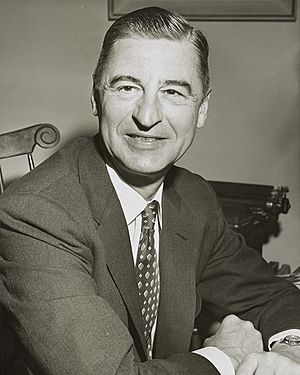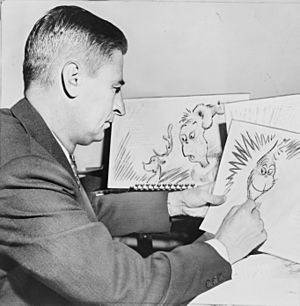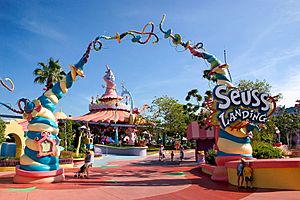Dr. Seuss facts for kids
Quick facts for kids
Dr. Seuss
|
|
|---|---|

Dr. Seuss in 1957
|
|
| Born | Theodor Seuss Geisel March 2, 1904 Springfield, Massachusetts, U.S. |
| Died | September 24, 1991 (aged 87) San Diego, California, U.S. |
| Pen name |
|
| Occupation |
|
| Education | |
| Genre | Children's literature |
| Years active | 1921–1990 |
| Spouse | |
|
|
|
| Signature |  |
Theodor Seuss Geisel ( March 2, 1904 – September 24, 1991) was an American children's author and cartoonist. He is known for his work writing and illustrating more than 60 books under the pen name Dr. Seuss. His work includes many of the most popular children's books of all time, selling over 600 million copies and being translated into more than 20 languages by the time of his death.
Contents
Early years
Geisel was born and raised in Springfield, Massachusetts. His parents were Henrietta (née Seuss) and Theodor Robert Geisel. Mulberry Street in Springfield, made famous in his first children's book And to Think That I Saw It on Mulberry Street, is near his boyhood home on Fairfield Street.
Geisel attended Dartmouth College, graduating in 1925. At Dartmouth, he joined the Sigma Phi Epsilon fraternity and the humor magazine Dartmouth Jack-O-Lantern, eventually rising to the rank of editor-in-chief. Arounf this time, Geisel began signing his work with the pen name "Seuss". He was encouraged in his writing by professor of rhetoric W. Benfield Pressey, whom he described as his "big inspiration for writing" at Dartmouth.
Upon graduating from Dartmouth, he entered Lincoln College, Oxford, intending to earn a Doctor of Philosophy (D.Phil.) in English literature. At Oxford, he met his future wife Helen Palmer, who encouraged him to give up becoming an English teacher in favor of pursuing drawing as a career.
Early career
Geisel left Oxford without earning a degree and returned to the United States in February 1927. He immediately began submitting writings and drawings to magazines, book publishers, and advertising agencies.
His first nationally published cartoon appeared in the 16 July 1927, issue of The Saturday Evening Post. This single $25 sale encouraged Geisel to move from Springfield to New York City. Later that year, Geisel accepted a job as writer and illustrator at the humor magazine Judge, and he felt financially stable enough to marry Palmer. His first cartoon for Judge appeared on October 22, 1927, and Geisel and Palmer were married on November 29. Geisel's first work signed "Dr. Seuss" was published in Judge about six months after he started working there.
His work was in demand and began to appear regularly in magazines such as Life, Liberty and Vanity Fair.
The money Geisel earned from his advertising work and magazine submissions made him wealthier than even his most successful Dartmouth classmates. The increased income allowed the Geisels to move to better quarters and to socialize in higher social circles. They became friends with the wealthy family of banker Frank A. Vanderlip. They also traveled a lot: by 1936, Geisel and his wife had visited 30 countries together. They did not have children, neither kept regular office hours, and they had ample money. Geisel also felt that traveling helped his creativity.
Children's books
In 1936, Geisel and his wife were returning from an ocean voyage to Europe when the rhythm of the ship's engines inspired the poem that became his first children's book: And to Think That I Saw It on Mulberry Street. Based on Geisel's varied accounts, the book was rejected by between 20 and 43 publishers. According to Geisel, he was walking home to burn the manuscript when a chance encounter with an old Dartmouth classmate led to its publication by Vanguard Press.
Geisel wrote four more books before the US entered World War II. This included The 500 Hats of Bartholomew Cubbins in 1938, as well as The King's Stilts and The Seven Lady Godivas in 1939, all of which were in prose, atypically for him. This was followed by Horton Hatches the Egg in 1940, in which Geisel returned to the use of verse.
During World War II, he took a brief hiatus from children's literature to illustrate political cartoons, and he also worked in the animation and film department of the United States Army where he wrote, produced or animated many productions including Design for Death, which later won the 1947 Academy Award for Best Documentary Feature Film.
After the war, Geisel returned to writing children's books, writing classics like If I Ran the Zoo (1950), Horton Hears a Who! (1955), The Cat in the Hat (1957), How the Grinch Stole Christmas! (1957), Green Eggs and Ham (1960), One Fish, Two Fish, Red Fish, Blue Fish (1960), The Sneetches and Other Stories (1961), The Lorax (1971), The Butter Battle Book (1984), and Oh, the Places You'll Go! (1990). He published over 60 books during his career, which have spawned numerous adaptations, including 11 television specials, five feature films, a Broadway musical, and four television series.
Cat in the Hat

In May 1954, Life published a report on illiteracy among school children which concluded that children were not learning to read because their books were boring.
William Ellsworth Spaulding, who was the director of the education division at Houghton Mifflin at that time, compiled a list of 348 words that he felt were important for first-graders to recognize. He asked Geisel to cut the list to 250 words and to write a book using only those words. Spaulding challenged Geisel to "bring back a book children can't put down".
Nine months later, Geisel completed The Cat in the Hat, using 236 of the words given to him. It retained the drawing style, verse rhythms, and all the imaginative power of Geisel's earlier works but, because of its simplified vocabulary, it could be read by beginning readers. The Cat in the Hat and subsequent books written for young children achieved significant international success and they remain very popular today.
For example, in 2009, Green Eggs and Ham sold 540,000 copies, The Cat in the Hat sold 452,000 copies, and One Fish, Two Fish, Red Fish, Blue Fish (1960) sold 409,000 copies—all outselling the majority of newly published children's books.
Geisel went on to write many other children's books, both in his new simplified-vocabulary manner (sold as Beginner Books) and in his older, more elaborate style.
Personal life
Geisel's wife Helen had a long struggle with illnesses. On October 23, 1967, Helen died.
Eight months later, on June 21, 1968, Geisel married Audrey Dimond. Although he devoted most of his life to writing children's books, Geisel had no children of his own, saying of children: "You have 'em; I'll entertain 'em." Dimond added that Geisel "lived his whole life without children and he was very happy without children." Audrey oversaw Geisel's estate until her death on December 19, 2018, at the age of 97.
Death
Geisel died of cancer on September 24, 1991, at his home in the La Jolla community of San Diego at the age of 87. His ashes were scattered in the Pacific Ocean.
Interesting facts about Dr. Seuss
- As his family was of German descent, Geisel and his sister Marnie experienced anti-German prejudice from other children following the outbreak of World War I in 1914.
- He was raised as a Missouri Synod Lutheran and remained in the denomination his entire life.
- While Geisel was living in La Jolla, the United States Postal Service and others frequently confused him with fellow La Jolla resident Dr. Hans Suess, a noted nuclear physicist.
- Geisel's birthday, March 2, has been adopted as the annual date for National Read Across America Day, an initiative on reading created by the National Education Association.
- Geisel wrote most of his books in anapestic tetrameter, a poetic meter employed by many poets of the English literary canon. This is often suggested as one of the reasons that Geisel's writing was so well received.
- Geisel made a point of not beginning to write his stories with a moral in mind, stating that "kids can see a moral coming a mile off."
- Geisel's most famous pen name is regularly pronounced an anglicized pronunciation inconsistent with his German surname (the standard German pronunciation is). He himself noted that it rhymed with "voice" (his own pronunciation being). Alexander Laing, one of his collaborators on the Dartmouth Jack-O-Lantern, wrote of it:
You're wrong as the deuce
And you shouldn't rejoice
If you're calling him Seuss.
He pronounces it Soice (or Zoice)
Awards
- Geisel won the Lewis Carroll Shelf Award in 1958 for Horton Hatches the Egg and again in 1961 for And to Think That I Saw It on Mulberry Street.
- He received the Regina Medal award from the Catholic Library Association in 1982.
- He also received two Primetime Emmy Awards for Outstanding Children's Special for Halloween Is Grinch Night (1978) and Outstanding Animated Program for The Grinch Grinches the Cat in the Hat (1982).
- Geisel was awarded an honorary doctorate of Humane Letters (L.H.D.) from Whittier College in 1980.
- He also received the Laura Ingalls Wilder Medal from the professional children's librarians in 1980, recognizing his "substantial and lasting contributions to children's literature". At the time, it was awarded every five years.
- He won a special Pulitzer Prize in 1984 citing his "contribution over nearly half a century to the education and enjoyment of America's children and their parents".
Posthumous honors
- On December 1, 1995, four years after his death, University of California, San Diego's University Library Building was renamed Geisel Library in honor of Geisel and Audrey for the generous contributions that they made to the library and their devotion to improving literacy.
- In 2002, the Dr. Seuss National Memorial Sculpture Garden opened in Springfield, Massachusetts, featuring sculptures of Geisel and of many of his characters.
- In 2017, the Amazing World of Dr. Seuss Museum opened next to the Dr. Seuss National Memorial Sculpture Garden in the Springfield Museums Quadrangle.
- In 2008, Dr. Seuss was inducted into the California Hall of Fame. On March 2, 2009, the Web search engine Google temporarily changed its logo to commemorate Geisel's birthday (a practice that it often performs for various holidays and events).
- In 2004, U.S. children's librarians established the annual Theodor Seuss Geisel Award to recognize "the most distinguished American book for beginning readers published in English in the United States during the preceding year". It should "demonstrate creativity and imagination to engage children in reading" from pre-kindergarten to second grade.
- At Geisel's alma mater of Dartmouth, more than 90 percent of incoming first-year students participate in pre-matriculation trips run by the Dartmouth Outing Club into the New Hampshire wilderness. It is traditional for students returning from the trips to stay overnight at Dartmouth's Moosilauke Ravine Lodge, where they are served green eggs for breakfast. On April 4, 2012, the Dartmouth Medical School was renamed the Audrey and Theodor Geisel School of Medicine in honor of their many years of generosity to the college.
- Dr. Seuss's honors include two Academy Awards, two Emmy Awards, a Peabody Award, the Laura Ingalls Wilder Medal, the Inkpot Award and the Pulitzer Prize.
- Dr. Seuss has a star on the Hollywood Walk of Fame at the 6500 block of Hollywood Boulevard.
- Dr. Seuss has been in Forbes' list of the world's highest-paid dead celebrities every year since 2001, when the list was first published.
- Dr. Seuss was honored with a Google Doodle in March 2, 2009 in celebration of his 105th birthday.
Dr. Seuss quotes
- "Don't cry because it's over. Smile because it happened."
- "Unless someone like you cares a whole awful lot, nothing is going to get better. It's not."
- "You're in pretty good shape for the shape you are in."
- "You're never too old, too wacky, too wild, to pick up a book and read to a child."
Adaptations
For most of his career, Geisel was reluctant to have his characters marketed in contexts outside of his own books. However, he did permit the creation of several animated cartoons, an art form in which he had gained experience during World War II, and he gradually relaxed his policy as he aged.
The first adaptation of one of Geisel's works was a cartoon version of Horton Hatches the Egg, animated at Warner Bros. in 1942 and directed by Bob Clampett. It was presented as part of the Merrie Melodies series and included a number of gags not present in the original narrative.
Theatrical short films
| Year | Title | Format | Director | Distributor | Length | Ref(s) |
|---|---|---|---|---|---|---|
| 1942 | Horton Hatches the Egg | traditional animation | Bob Clampett | Warner Bros. Pictures | 10 min. | |
| 1943 | The 500 Hats of Bartholomew Cubbins | stop motion | George Pal | Paramount Pictures | ||
| 1944 | And to Think That I Saw It on Mulberry Street | |||||
| 1950 | Gerald McBoing-Boing | traditional animation | Robert Cannon | UPA and Columbia Pictures |
Theatrical feature films
| Year | Title | Format | Director(s) | Distributor | Studio | Length | Budget | Ref(s) |
|---|---|---|---|---|---|---|---|---|
| 1953 | The 5,000 Fingers of Dr. T. | live-action | Roy Rowland | Columbia Pictures | A Stanley Kramer Company Production | 92 min. | $2.75 million | |
| 2000 | How the Grinch Stole Christmas | Ron Howard | Universal Pictures | Imagine Entertainment | 104 min. | $123 million | ||
| 2003 | The Cat in the Hat | Bo Welch | Universal Pictures and DreamWorks Pictures | 82 min. | $109 million | |||
| 2008 | Horton Hears a Who! | computer animation | Jimmy Hayward & Steve Martino | 20th Century Fox | 20th Century Fox Animation Blue Sky Studios |
86 min. | $85 million | |
| 2012 | The Lorax | Chris Renaud and Kyle Balda | Universal Pictures | Illumination Entertainment | $70 million | |||
| 2018 | The Grinch | Scott Mosier and Yarrow Cheney | 90 min. | $75 million |
Television specials
| Year | Title | Format | Studio | Director | Writer | Distributor | Length |
|---|---|---|---|---|---|---|---|
| 1966 | How the Grinch Stole Christmas! | traditional animation | Chuck Jones Productions | Chuck Jones | Dr. Seuss, Irv Spector, and Bob Ogle | MGM | 25 min. |
| 1970 | Horton Hears a Who! | Dr. Seuss | |||||
| 1971 | The Cat in the Hat | DePatie-Freleng Enterprises | Hawley Pratt | CBS | |||
| 1972 | The Lorax | ||||||
| 1973 | Dr. Seuss on the Loose | ||||||
| 1975 | The Hoober-Bloob Highway | Alan Zaslove | |||||
| 1977 | Halloween Is Grinch Night | Gerard Baldwin | ABC | ||||
| 1980 | Pontoffel Pock, Where Are You? | ||||||
| 1982 | The Grinch Grinches the Cat in the Hat | Bill Perez | |||||
| 1989 | The Butter Battle Book | Bakshi Production | Ralph Bakshi | Turner | |||
| 1995 | Daisy-Head Mayzie | Hanna-Barbera Productions | Tony Collingwood |
Television series
| Year | Title | Format | Director | Writer | Studio | Network |
|---|---|---|---|---|---|---|
| 1996–1998 | The Wubbulous World of Dr. Seuss | live-action/puppet | Various | Various | Jim Henson Productions | Nickelodeon |
| 2010–2018 | The Cat in the Hat Knows a Lot About That! | traditional animation | Collingwood O'Hare Productions Portfolio Entertainment Random House Children's Entertainment KQED |
Treehouse TV | ||
| 2019–2022 | Green Eggs and Ham | Gulfstream Pictures A Stern Talking To A Very Good Production Warner Bros. Animation |
Netflix |
See also
 In Spanish: Dr. Seuss para niños
In Spanish: Dr. Seuss para niños
- The Cat in the Hat (play)
- Dr. Seuss bibliography
- "The Sidewinder Sleeps Tonite" – a 1992 R.E.M. song referencing a reading from Seuss.
- Origins of a Story




